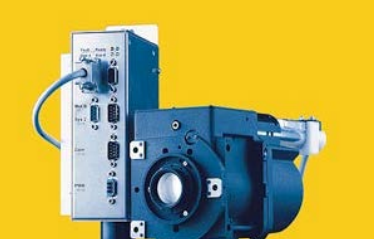The Variogon lens
Fig. 1: Optical and mechanical competence in construction and production: Cross section of the 30-fold zoom-lens Variogon 1.8 / 6 - 180 mm for Super-8mm narrow-gauge film.
In the most recent technical innovation in photography, digital photography, the Variogon has also assumed a position of importance. As an integrated lens with variable focal length, it finds use in the series of various Kodak EasyShare zoom digital cameras.
Vario-lenses were already under development at Schneider-Kreuznach by the mid-50s.Because of our extensive experience in optical calculation, construction, and full-scale serial production, the vario-lenses were found in a wide range of applications:
- For television (TV-Variogon) and surveillance cameras
- in the still photography (single-lens reflex cameras) - here again in the 35 mm and medium-format sector
- for enlargers in the darkroom (Betavaron)
- for variable still projection (Vario-Cine-Xenon)
- in various OEM applications for designed specifically for certain customers, e.g., in printing, scanning and reproduction technology (Variomorphot)
The way a zoom lens works
The secret of a Variogon, i.e. of a vario- or zoom lens, is that it cleverly takes advantage of a number of basic optical laws, and by appropriately correcting the aberrations which arise in connection with them, makes it possible to achieve good imaging quality. To this end, there are three essential preconditions: adequate computer programs, high-performance computers, and above all, the optical-physical know how.
The zoom lenses of today are very complex, both in their construction and their mode of operation. For that reason, to better understand how the traditional Variogon lens, its main principle of operation is described below. All zoom lenses, however, have the property of projecting the image to be depicted exactly onto a fixed local imaging plane, be it the surface of the film or the plane of an image sensor, while the focal length is being changed.
The principle of design of a Variogon of the traditional type of construction is easy to understand. The essential factor is that the image is not projected directly onto the film, but arrives there only after several intermediate virtual images have been created.
The first lens group creates an image of the subject like any other lens. Only this part of the optical system is adjusted for the distance from the subject, not the entire lens, as is often customary. From this first image, a second group of lens elements creates a second image; it is only the third group of lens elements that creates the final image.
Because the second group is shifted, the image ratio from the first to the second intermediate image is changed, and with it the size, too, of the subject as it finally appears on the sensitive medium (Fig. 1). But at the same time, this means that the focal length of the entire system has been changed. With the axial shift, however, the position of the second and third realized image has changed. So that the user does not have to re-focus after every change in the focal length, another lens group is brought into play. Its function is to restore the sharpness simultaneously with the change in the focal length.
The variation in focal length can be realized basically in two ways. In one case, the two lens groups are controlled mechanically in such a way that both carry out specific, but different, movements ( mechanical compensation ), in the other case, both lens groups are moved together; then, by a clever choice of the optical values of both components, one can keep the position of the image constant; to be sure, in this second case, in theory not entirely strictly, but in practice with sufficient precision ( optical compensation ).
As a practical example of the principle illustrated in Fig. 2, the Variogon 1:2.8/10-40 is shown in cross-section. The individual elements are indicated with Roman numerals.
In some cases, the third group of lens elements is divided in such a way (lIla and IIIb in Fig. 3) that the rays between them are parallel. Then one can imagine the entire lens in this position as separated into a supplementary lens without focal length and the main lens. Lenses without focal length function to a certain extent like Galileo's telescope , which, depending on which end one looks into, makes the image larger or smaller. When the supplementary lens enlarges, the focal length of the combination is lengthened, and vice versa. The supplementary part of the Variogon is such that one can change its enlarging property constantly, and hence the focal length of the lens can be adjusted as desired.
As early as the thirties in Germany, lenses of this kind appeared on the market and attracted a great deal of attention; after the war, the "Optical Works Jos. Schneider & Co." was the first German firm to create such a lens for 8-mm narrow-gauge cine cameras. This was the Variogon 2,8/10-40 mm, which is shown in Fig. 4.

Fig. 1: Schematic representation of the basic structure of a Variogon lens
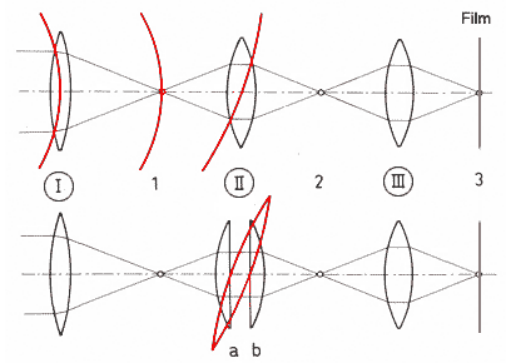
Fig. 2 : 2: Mechanical compensation for the change in the focal distance.
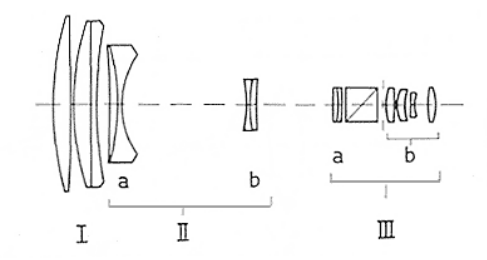
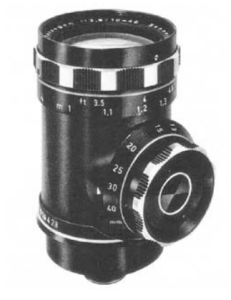
Fig. 4: Variogon 2,8/10-40 mm
Fig. 3: Practical demonstration using the Variogon 2.8/10-40 mm. In the practical demonstration in Fig. 2, one part of the lens group has negative refractive power and the intermediate images are virtual images.
Zoom lenses for narrow-gauge cine cameras
The history of the Variogon zoom-lens is closely tied to that of the narrow-gauge cine film era. An impeccable sharpness of focus right into the corners of the image, even with varying focal lengths, was a basic precondition of its success. The first lenses with variable focal length for narrow-gauge cine cameras appear as early as the year 1937; they were used on a 16-mm Siemens camera. Wider use, however, only became possible beginning in the fifties, through the use of computers.
This development ran parallel to technical progress in the antireflection coating of optical lenses. Because of the relatively large number of lens elements, the high degree of transparency of the glass became especially important. Even at the time of the normal-8-format ( 3.6 x 4.9 mm2), almost all manufacturers of narrow-gauge cine cameras in Europe made use of the Schneider-Variogon. The first types that time:
- Variogon 2,8 / 10-40 mm,
- Variogon 1,8 / 9-30 mm,
- Variogon 1,8 / 7,5-37,5 mm,
- Variogon 1,8 / 8-48 mm.
With the introduction of the Super-8-format on the market, a larger picture format (4.22 x 5.69 mm2) was possible, and with it a picture area about 40% larger, which in all areas, and even at full aperture, was distinguished by its sharpness.
The underlying principle of this type of Variogon was based on the mechanically compensated focal distance adjustment. In this system, mechanical radial cams move two lens groups according to mathematical-physical guidelines I and II relative to one another - in Fig. 3 represented by blue lines - in order to continuously change the focal length of the lens. As a result, the locus of the picture always remains in the same position, the film plane. The camera-to-subject distance is set with the front group of lens elements.
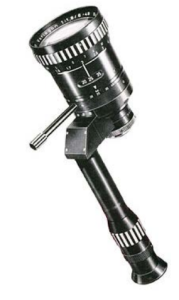
Fig. 1: Variogon 1.8 / 8 - 48 mm for normal-8-narrow-gauge film with reflex viewfinder
With lenses with a viewfinder - Narrow-gauge film see Fig. 1, - a beam splitter is situated in front of the iris diaphragm. An overall view of the Variogon and Optivaron lenses from our earlier product line for Super-8- narrow-gauge cine cameras is presented in a brochure. What is remarkable is the 30-fold zoom lens that was made at the end of the seventies for Beaulieu Cameras.
Fig. 3 right: Principle of function of the mechanical focal distance adjustment
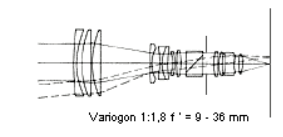
Fig. 2: Because of the construction and the opticalmechanical action, the locus of the picture remains remains constant, and the picture quality is largely maintained.
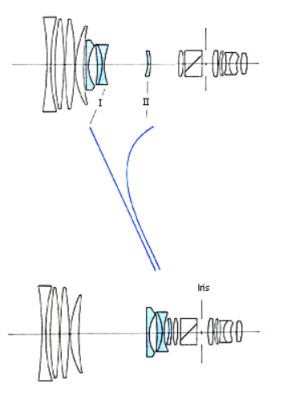
Zoom lenses for television
The development of lenses of adjustable focal lengths, the so-called zoom- or Vario-lenses, was already under way at Schneider-Kreuznach in 1957. Two years later, production of the first prototype began, the Variogon 2,8/10-40 mm, for the 8mm film size. At the same time as the development of zoom lenses for other formats, such as the Super-8-, 16 mm- and 35 mm- /medium-format, development was under way for color television cameras with all current formats from ½" to 1¼".
The following configurations provide a brief look into the history of the TV-Variogons. In studio or ENG/EFP1) configurations, they were in use world-wide on the television cameras of leading manufacturers2). Numerous patents document the innovative development phase in the seventies through the nineties.
C-Mount zoom lenses of the 2/3" standard construction series, on the other hand, are still today among the range of lens products for industrial applications.
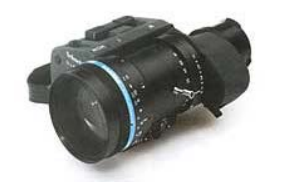
Fig. 1: ENG television lens APO-Varon HM 14X, Type TV59.02, for 1/2"

Fig. 2 Studio television lens 30X Variogon 2.1/16 - 480 mm, Type TV 31, for 1¼"
Good light transmission by the lens
(spectral transmission)
At that time, the first 30-fold zoom TV lens with two optical zoom groups for adjustment of the focal length , each consisting of a zoom component and a compensator was regarded as a technological advance. Unlike the customary method of construction, the patented TV-Variogon operated on the following principle.
All in all, eight operational components were required. Three of them ( 1.2, 4 and 7 ) remain fixed, four ( 2, 3, 5 and 6 ) are axially movable to change the focal length, and 1.1 is to adjust the camera-to-subject distance.
The value s' is the distance between the last lens surface and image plane B, the so-called back focal distance. Fig. 4 conveys an impression of the optical components Television formats ½" to 1 ¼" ( 31 lenses in 22 elements ), which are required for this purpose.
For the mechanical realization of a larger range of focal lengths according to the optical functional principle in Fig. 4, the two zoom components are driven reciprocally by means of a differential mechanism.
The culmination of many years of developmental activities in the area of television lenses was marked by the innovative change from mechanical to electronic control of the position of the movable optical zoom components. On the occasion of the International Symposiums 1987 in Montreux, Schneider-Kreuznach introduced the first TV zoom lens for the 1"-picture size notcontrolled by cam gears. The 16-bit lens controlled by a microprocessor, the TV 91, attained a 35-fold variation in focal length.
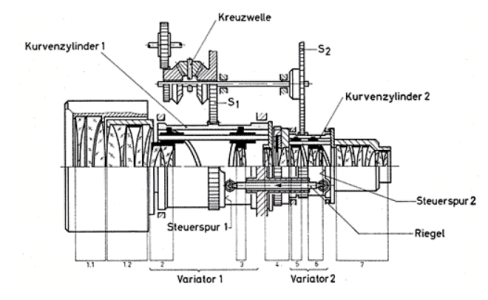
Fig. 5: TV-Variogon with two optical zoom components

Fig. 3: TV-Variogon with two optical zoom components
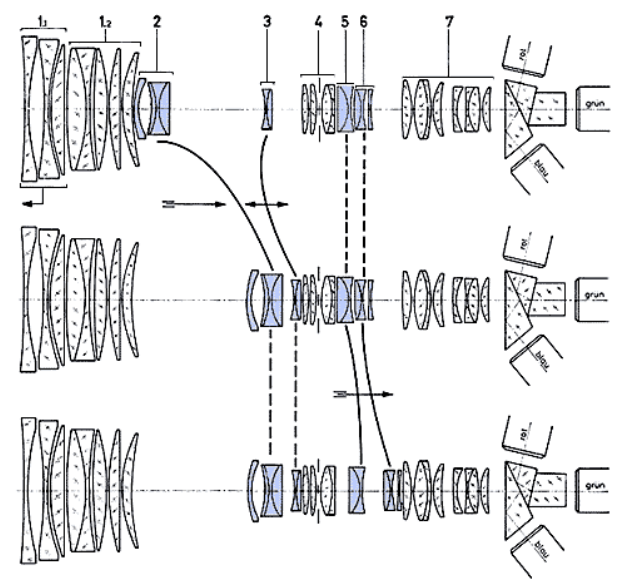
Fig. 4: Optical structure of the 30-fold zoom television lens TV-Variogon 2.1 - 6.6 / 20 - 600 mm with the shortest focal length and focus on infinity
Zoom lenses for still camera photography
Our experience in the construction of zoom lenses for film and television cameras also inspired the development and construction of the Variogon for the 35 mm and mediumformat. The Variogons of still camera photography were placed in single-lens reflex cameras with a focal-plane and between-the-lens shutter (e.g., Rollei), because only there could the variably dimensioned viewfinder image be observed and adjusted on a ground-glass focusing screen.
Fig. 1 shows by way of example the configuration of the Tele-Variogon 4/80-240 mm with the diaphragm and shutter controls on the hand grip. A high-speed Variogon 2.8/45- 100 mm was an addition to the product series. With the appropriate adapter base, both lenses could also be used on 8-, 16- and 35-mm film cameras.
Some technical details:
- mechanical focal distance adjustment of the highest accuracy,
- focusing by means of a knurled on the front side,
- a click-stop diaphragm for diaphragm presetting,
- diaphragm opener for viewing the picture image without changing the selected aperture adjustment for picture monitoring,
- a total of 19 interchangeable adapters for use with single-lens reflexcameras with focal-plane shutter,
- the camera on which the lens is mounted can, if desired, be shifted by means of a notch und lever for vertical or horizontal format.
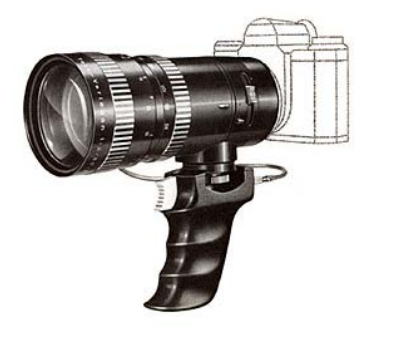
Fig. 1: Tele-Variogon 4 / 80 - 240 mm
Zoom lenses for enlarger and printers
What the Variogon is for the photo and film technology, the Betavaron is for enlargers and printers: a lens with a continuously variable image ratio combined with constant high imaging quality. While up to now several fixed-focal-length lenses have been required for different enlargement sizes, these have now been replaced by a single lens - the Betavaron. It is world-wide the first zoom lens for enlargers and printers.
Intended at first for traditional enlargers and printers, the Betavaron also finds use today in OEM applications modified for individual customers for their specific purposes.
The typical Betavaron for enlargers in Fig. 1 makes possible, in addition to completely new picture effects, a considerable simplification of enlarging procedures, thus significantly reducing the time and effect hitherto required for these tasks. After the correct aperture setting and exposure time have been determined for a specific image ratio, when that imageratio is changed, the required correction of aperture and exposure can then be ascertained by referring to a table.
With the exemplary Betavaron ( Fig. 1), at a constant distance between negative and positive, changes in the scale of reproduction from 3.1- to 10-fold can be made continuously. The value 0.08 characterizes the numerical aperture on the negative side. Especially coordinated close-up lenses, which with the help of a bayonet can be attached to the zoom lens, give the user a wide range of applications.
After a one-time setting on the enlarger, the positions of Negative (A), Positive (B), and Enlargement lens (G, F) relative to one another remain constant. By simply moving the focusing ring (F) for the image ratio, the desired enlargement or that part of the negative which completely fills the frame can be easily and quickly focused for the desired positive format. In so doing, the sharpness and imaging quality is fully retained over the entire focusing range. The diaphragm is adjusted with the knurled ring (G).
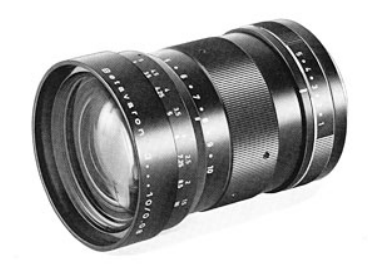
Fig. 1: Betavaron 3,1 ... 10 / 0,08 With the exemplary Betavaron ( Fig. 1), at a constant distance between negative and positive
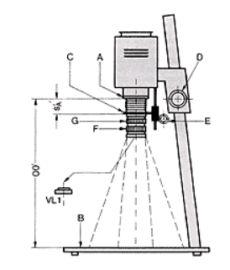
Fig. 2: Enlarger with Betavaron
Industrial optical systems with vario lenses
As an example of solutions for specific customers, the adjacent figure shows a complex industrial application with a fast motorized zoom lens. The optical construction is based on a modified Variogon.
Fig 3 right: An electronic/mechanical/optical modular unit


















